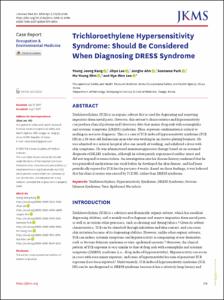Trichloroethylene Hypersensitivity Syndrome: Should Be Considered When Diagnosing DRESS Syndrome
- Keimyung Author(s)
- Lee, Hye Won
- Department
- Dept. of Pathology (병리학)
- Journal Title
- Journal of Korean Medical Science
- Issued Date
- 2018
- Volume
- 33
- Issue
- 14
- Keyword
- DRESS Syndrome; Hypersensitivity Syndrome; Stevens-Johnson Syndrome; Toxic Epidermal Necrolysis; Trichloroethylene
- Abstract
- Trichloroethylene (TCE) is an organic solvent that is used for degreasing and removing impurities from metal parts. However, this solvent's characteristics and hypersensitivity can produce clinical patterns and laboratory data that mimic drug rash with eosinophilia and systemic symptoms (DRESS) syndrome. Thus, exposure confirmation is critical to making an accurate diagnosis. This is a case of TCE-induced hypersensitivity syndrome (TCE HS) in a 24-year-old Indonesian man who was working in an electro-plating business. He was admitted to a referral hospital after one month of working, and exhibited a fever with skin symptoms. He was administered immunosuppressive therapy based on an assumed diagnosis of DRESS syndrome, although he subsequently experienced cardiac arrest and did not respond to resuscitation. An investigation into his disease history confirmed that he was prescribed medications one week before he developed the skin disease, and had been periodically exposed to TCE for the previous 4 weeks. Based on these findings, it was believed that his clinical course was caused by TCE HS, rather than DRESS syndrome.
- Keimyung Author(s)(Kor)
- 이혜원
- Publisher
- School of Medicine (의과대학)
- Citation
- Young Joong Kang et al. (2018). Trichloroethylene Hypersensitivity Syndrome: Should Be Considered When Diagnosing DRESS Syndrome. Journal of Korean Medical Science, 33(14), e106–e106. doi: 10.3346/jkms.2018.33.e1
- Type
- Article
- ISSN
- 1011-8934
- Appears in Collections:
- 1. School of Medicine (의과대학) > Dept. of Pathology (병리학)
- 파일 목록
-
-
Download
 oak-2018-1204.pdf
기타 데이터 / 1.54 MB / Adobe PDF
oak-2018-1204.pdf
기타 데이터 / 1.54 MB / Adobe PDF
-
Items in Repository are protected by copyright, with all rights reserved, unless otherwise indicated.